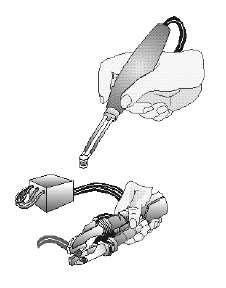2-31
Overheating small or delicate wiring can easily occur when a soldering gun is used. For most jobs,
even the LOW position of the trigger overheats the gun after 10 seconds. With practice, the heat can be
controlled by pulsing the gun on and off with its trigger. The HIGH position is used only for fast heating
and for soldering heavy connections.
When a soldering iron or gun is used, heating and cooling cycles tend to loosen the nuts or screws
that hold the replaceable tips. When the nut on a gun becomes loose, the resistance of the tip connection
increases. The temperature of the connection is increased, thus reducing the heat at the tip. Continued
loosening may eventually cause an open circuit. Therefore, check and tighten the nut or screw, as needed.
CAUTION
Soldering guns should never be used to solder electronic components, such as
resistors, capacitors, and transistors, because the heat generated can destroy the
components. They should be used only on terminals, splices, and connectors (not the
miniature type).
Q30. What happens if a soldering gun switch is pressed for periods longer than 30 seconds?
Q31. What causes the nuts or screws that hold the tips on soldering irons and guns to loosen?
Q32. A soldering gun should NOT be used on what components?
Resistance Soldering Set
A time-controlled resistance soldering set (figure 2-32) is now used at many maintenance activities.
The set consists of a transformer that supplies 3 or 6 volts at a high current to stainless steel or carbon
tips. The transformer is turned ON by a foot switch and OFF by an electronic timer. The timer can be
adjusted for as long as 3 seconds soldering time. This set is especially useful for soldering cables to plugs
and similar connectors; even the smallest types.
Figure 2-32.—Resistance soldering set
In use, the double-tip probes of the soldering unit are adjusted to straddle the connector cup
(connector barrel) to be soldered. One pulse of current heats it for tinning. After the wire is inserted, a

